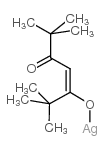79827-25-1
| Name | 2,2,6,6-tetramethyl-3,5-heptanedionato silver (i) |
|---|---|
| Synonyms |
TetramethylheptanedionatosilverI
silver 2,2,6,6-tetramethyl-3,5-heptanedionate 2,2,5-TRIMETHYL-1,3-DIOXANE-5-CARBOXYLIC ACID VINYL ESTER-D3 |
| Melting Point | 178ºC (dec.) |
|---|---|
| Molecular Formula | C11H19AgO2 |
| Molecular Weight | 291.13600 |
| Exact Mass | 290.04400 |
| PSA | 26.30000 |
| LogP | 3.01250 |
|
Section 1: Product Identification Chemical Name:2,2,6,6-Tetramethyl-3,5-heptanedionato silver (I) (99.9%-Ag) [Ag(TMHD)] CAS Registry Number:79827-25-1 Formula:AgC11H19O2 EINECS Number:none Chemical Family:metal beta-diketonate complexes Synonym:Dipivaloylmethane, silver complex
Section 2: Composition and Information on Ingredients IngredientCAS NumberPercentACGIH (TWA)OSHA (PEL) Title Compound79827-25-1100%no datano data Section 3: Hazards Identification No reports could be found indicating specific hazards are associated with this material. Toxicity is probably Emergency Overview: minimal. Primary Routes of Exposure:Ingestion, Inhalation of dust. Eye Contact:May cause slight to mild irritation of the eyes. May cause slight to mild irritation of the skin. Contact with the skin can lead to formation of dark blotches Skin Contact: (silver staining) Inhalation:Dust may be irritating to the nose, mucous membranes and respiratory tract. Ingestion:No information on the physiological effects of ingestion. Acute Health Affects:May be irritating to skin, eyes and respiratory tract. Chronic Health Affects:No information available on long-term chronic effects. NTP:No IARC:No OSHA:No SECTION 4: First Aid Measures Immediately flush the eyes with copious amounts of water for at least 10-15 minutes. A victim may need Eye Exposure: assistance in keeping their eye lids open. Get immediate medical attention. Wash the affected area with soap and water. Remove contaminated clothes if necessary. Seek medical Skin Exposure: assistance if irritation persists. Remove the victim to fresh air. Closely monitor the victim for signs of respiratory problems, such as difficulty Inhalation: in breathing, coughing, wheezing, or pain. In such cases seek immediate medical assistance. Ingestion:Seek medical attention immediately. Keep the victim calm. Give the victim water (only if conscious). SECTION 5: Fire Fighting Measures Flash Point:not applicable Autoignition Temperature:none Explosion Limits:none Extinguishing Medium:carbon dioxide, dry powder or foam If involved in a fire, fire fighters should be equipped with a NIOSH approved positive pressure self-contained Special Fire Fighting Procedures: breathing apparatus and full protective clothing. Hazardous Combustion andIf involved in a fire this material may emit toxic organic fumes. Decomposion Products: Unusual Fire or Explosion Hazards: No unusual fire or explosion hazards. SECTION 6: Accidental Release Measures Spill and Leak Procedures:Small spills can be mixed with vermiculite or sodium carbonate and swept up. SECTION 7: Handling and Storage Handling and Storage:Store in a sealed container. Keep away from heat and moisture. SECTION 8: Exposure Controls and Personal Protection Eye Protection:Always wear approved safety glasses when handling a chemical substance in the laboratory. Skin Protection:Wear appropriate chemical resistant gloves and protective clothing. Ventilation:Material may form a fine dust. If possible, handle the material in an efficient fume hood. If in form of fine dust and ventilation is not available a respirator should be worn. The use of respirators Respirator: requires a Respirator Protection Program to be in compliance with 29 CFR 1910.134. Ventilation:Material may form a fine dust. If possible, handle the material in an efficient fume hood. Additional Protection:No additional protection required. SECTION 9: Physical and Chemical Properties Color and Form:gray pwdr. Molecular Weight:291.14 Melting Point:178° dec. Boiling Point:no data Vapor Pressure:not applicable Specific Gravity:no data Odor:none Solubility in Water:insoluble SECTION 10: Stability and Reactivity Stability:air and moisture stable solid Hazardous Polymerization:no hazardous polymerization Conditions to Avoid:none Incompatibility:oxidizing agents Decomposition Products:Carbon dioxide, carbon monoxide, organic vapors, and metal oxides and carbonates. SECTION 11: Toxicological Information RTECS Data:No information available in the RTECS files. Carcinogenic Effects:No data available Mutagenic Effects:No data available Tetratogenic Effects:No data available SECTION 12: Ecological Information Ecological Information:No information available SECTION 13: Disposal Considerations Disposal:Dispose of according to local, state and federal regulations. SECTION 14: Transportation Shipping Name (CFR):Non-hazardous Hazard Class (CFR):NA Additional Hazard Class (CFR):NA Packaging Group (CFR):NA UN ID Number (CFR):NA Shipping Name (IATA):Non-hazardous Hazard Class (IATA):NA Additional Hazard Class (IATA):NA Packaging Group (IATA):NA UN ID Number (IATA):NA SECTION 15: Regulatory Information TSCA:Not listed in the TSCA inventory. SARA (Title 313):Title compound: See Category Code N740 for reporting. Second Ingredient:none SECTION 16 - ADDITIONAL INFORMATION N/A |
| Risk Phrases | 36/37/38 |
|---|---|
| Safety Phrases | 26-36/37/39 |
